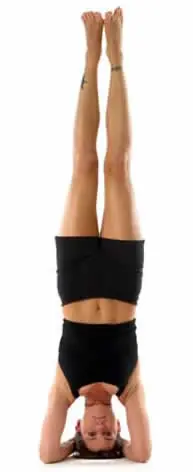How to: Head Stand Pose
Start by kneeling on the floor. Rest on your forearms. Wrap your hands around your elbows to ensure they are shoulders width apart. Without moving your elbows from this position, swing your forearms to interlace your fingers. Your palms will face you and create a gentle guide for the back of your head as you place the top of your head on the floor. For proper neck safety, ensure that your body weight is supported by your arms and not your head or neck.
I recommend practicing close to a wall until you become confident. Slowly tuck your toes under and straighten your legs. It should look like you are doing a downward facing dog on your forearms and head. You can stay here for several attempts until the weight on the top of your head becomes second nature. Next, walk your feet in a position as close to your head as possible without bending your knees. At the same time, keep your head in a straight line with your spine. Bend your knees into your chest. Then, lift your feet off the floor. You will want to move the hips back to counterbalance your weight. Take several breaths in this bent knee position until you are comfortable straightening your legs.

Most of the weight should be felt in the arms, not the head. With each exhale, remember to lift your shoulders away from your ears and to elongate your neck. Keep your legs active and pressed together in the pose. Focus your energy up through them.
Benefits of Head Stand Pose
When performed properly and consistently, head stand can:
- Enhance concentration
- Improve internal organ function
- Nourish the skin of the face
- Calm the body and mind
- Relieve stress and tension
- Strengthen the shoulders and the upper back muscles
- Tighten the abdominals
- Bring better circulation to the neck and brain
- Help varicose veins
- Increase stamina
For the lay person or yogi, head stand is effective in relieving mild depression. Inverted postures such as the king posture of head stand can increase the levels of blood, oxygen and glucose to the brain and create more dopamine and serotonin.
Head stand also stimulates the pituitary gland, which releases endorphins and reduces levels of the stress hormone Cortisol. The continued practice of head stand can alter your brain chemistry and aid you in producing ideal levels naturally.
For the athlete, head stand has many major benefits to improve performance. This pose reverses the effects of gravity on the lungs and diaphragm, strengthens the diaphragm, and assists in more complete exhalation. The more endurance athletes practice efficient breathing, the better and longer their quality play will be. For athletes who experience exercise-induced asthma, head stand offers breathing mechanisms to increase an athlete's endurance. For athletes who have the heavy or lead leg feeling after a hard day of competition or training, head stand helps to drain lymph. Regular practice of inversions increases the lymph drainage that might be "stuck" and restore the quickness.
Although you should always consult your physician and research a properly trained teacher before you start a yoga practice, there are a few instances where you should avoid this pose entirely if you have:
- Neck injuries
- Extremes in blood pressure
- Ear and eye problems
- Menstruation
- Back and shoulder injuries
- Certain heart disease
- Stroke
- Hiatal hernia
- Reflux
Have fun exploring this pose and learning about your body.


